Let’s look into some propositions on gold…
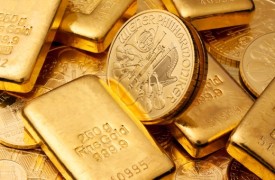 February 24, 2011 – Nothing seems to arouse passions – pro and con – quite like suggestions that gold should once again play a role in our money. “Only gold is money,” says one side. “It’s a barbarous relic,” says the other. Let’s turn down the heat a bit and look into some propositions about gold. That should lead us to some reasonable ideas about whether or how gold might return.
February 24, 2011 – Nothing seems to arouse passions – pro and con – quite like suggestions that gold should once again play a role in our money. “Only gold is money,” says one side. “It’s a barbarous relic,” says the other. Let’s turn down the heat a bit and look into some propositions about gold. That should lead us to some reasonable ideas about whether or how gold might return.
Gold Has Intrinsic Value
Actually, nothing has intrinsic value. The value of any good or service resides in the minds of individuals contemplating the benefits they might derive from it. What gold does have is some rather remarkable physical properties that make it very likely that people will continue to value it highly: luster, corrosion resistance, divisibility, malleability, high thermal and electrical conductivity, and a high degree of scarcity. All the gold ever mined would only fill one large swimming pool, and most of that gold is still recoverable.
Only Gold Is Money
Although gold was once used as money, that is no longer the case. Money is whatever is generally accepted as a medium of exchange in a particular historical setting. Right now, government-issued fiat money, unbacked by any commodity, is the only kind of money we find anywhere in the world, with some possible obscure exceptions.
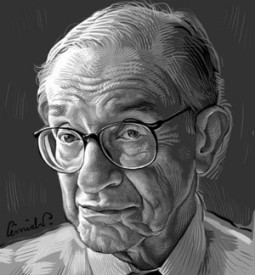
Alan Greenspan
What future Federal Reserve Chairman Alan Greenspan thought in 1967 when he wrote “Gold and Economic Freedom” for Ayn Rand’s newsletter. “In the absence of the gold standard, there is no way to protect savings from confiscation through inflation,” he said. When later asked by U.S. Rep. Ron Paul whether he stood by that article, Greenspan said he did. But he weaseled out by saying a return to gold was unnecessary because central banks had learned to produce the same results gold would produce.
The Gold Standard Is Too Rigid
The gold standard makes it impossible for a government central bank to conduct monetary policy – hooray! Under the Fed’s watch, the dollar has lost more than 95 percent of its purchasing power, and the economy was convulsed by the Great Depression of the 1930s, the stagflation of the 1970s, and the crash of 2008. Milton Friedman long ago explained the long and variable lags that follow monetary interventions and at one point called for replacing the Fed with a computer. The end of government economic manipulations in the form of monetary policy is a major potential benefit of a gold standard.
Gold is supposedly too rigid to accommodate increased demand for money at certain times of the year – historically harvest time and Christmas time – or in wartime. Falling prices are one way an economy can adjust to an increase in the demand for money, but this accommodation works best over a longer period. A short-term accommodation is possible when banks hold fractional reserves. On short notice and without any increase in monetary gold, fractional-reserve banks could simply issue more bank notes or their electronic equivalent during periods of high demand and retire them when demand subsided.
Inflation Is Impossible under a Gold Standard
Between 1897 and 1914 the gold stock rose at about 3.5 percent a year due to new discoveries and inflows from abroad. As a result, prices rose about 26 percent over this span, or about 1.4 percent per year. This was not a disruptive level of price inflation—but it was inflation.
The Gold Standard Was Tried and Failed
This is a plausible proposition, not to be dismissed out of hand. Nor may we simply note that because we never had a pure gold standard, the concept was never really tested. We must do better than that.
During much of our history, money was linked to gold in some degree, and there were some serious monetary problems during that time. The record of gold is bound up with the institutional arrangements that prevailed at various times in our history. Snapshots from that history should help illuminate this claim.
Before proceeding, we need a definition. Under a gold standard either private banks or a monopoly central bank issues notes (or their electronic equivalent) redeemable in gold. Gold coins may circulate as well. Notes may be fully or fractionally backed, meaning a note issuer may not have sufficient gold to redeem all outstanding notes at one time. In passing I assert, contrary to some “hard money” advocates, that fractional-reserve banking is an institution that is entirely compatible with free markets and the rule of law.
The period between the War of 1812 and the Civil War is commonly called the “free banking era.” It is also called the era of “wildcat banks” because many banks were poorly capitalized, poorly if not fraudulently managed, and prone to failure. Conventional wisdom says that this era demonstrates conclusively the need for strict government regulation of money and banking. Like other free-market institutions, free banking rests on the sanctity of property rights, with no government involvement other than prosecution of theft or fraud. But there was substantial government involvement all along, so the “free banking” label is only accurate in relative terms.
The most egregious departure from free-banking principles was the frequent suspension of specie payments: banks’ refusal to honor their obligation to redeem their banknotes for gold. These breaches of contract, which should have triggered liquidation and perhaps criminal prosecution, were in many instances tolerated or even encouraged by government authorities, especially during times of war or economic contraction.
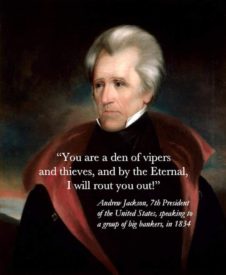 Second, the free-banking paradigm does not include a monopoly central bank. The Second Bank of the United States—roughly speaking, the U.S. central bank of its time – closed its doors in 1836. Its defeat, engineered by populist President Andrew Jackson, came with wide support from a public that had been generally suspicious of banks since the founding of the Republic. But the end of the Second Bank was by no means the end of federal government involvement in banking. With the Second Bank gone, the federal government still needed depositories for its funds. Certain private banks, which came to be known as “pet banks,” were selected for this privilege. This was one way in which the federal government continued to influence the banking system.
Second, the free-banking paradigm does not include a monopoly central bank. The Second Bank of the United States—roughly speaking, the U.S. central bank of its time – closed its doors in 1836. Its defeat, engineered by populist President Andrew Jackson, came with wide support from a public that had been generally suspicious of banks since the founding of the Republic. But the end of the Second Bank was by no means the end of federal government involvement in banking. With the Second Bank gone, the federal government still needed depositories for its funds. Certain private banks, which came to be known as “pet banks,” were selected for this privilege. This was one way in which the federal government continued to influence the banking system.
A third intervention, practiced by federal and state governments, was the prohibition of branch banking. No banks were allowed to cross state lines to open branches, and there were significant restrictions within most states as well. The strictest state laws forbade any branching whatever, while others allowed branching within their states on a limited basis. The result was that many communities could only be served by small, poorly capitalized, and often poorly managed local banks. Stronger city banks might have established branches in areas where early banks had failed or where none had emerged, particularly with the spread of the telegraph and railroads. But they were not allowed to do so. For confirmation of the ill effects of branch prohibition, we need only look as far as Canada, which has always had a few strong nationwide banks. During the Great Depression, when some 9,000 U.S. banks failed, not a single Canadian bank went under.
Fourth, many state governments required banks to hold their bonds as part of their reserves. This, of course, provided a captive market for such bonds. The National Banking System, established after the Civil War, imposed a requirement to hold federal Treasury securities. Thus the five-dollar gold note, issued by the Farmers Gold Bank of San Jose, California, in 1874 promises to “pay the bearer on demand five dollars in gold coin.” But it also says the note is “secured by bonds of the United States deposited with the U.S. Treasurer at Washington.” In other words, the government gave the banks incentive to substitute bonds for some of the gold they might have held as reserves.
The Gold Standard Is to Blame for Severe Downturns in 1893 and 1907
The panic of 1893 was quite severe. That year saw numerous railroad bankruptcies, bank failures, and declining stock prices. Among the causes were general overbuilding of railroads, the Silver Purchase Act of 1890, and the protectionist McKinley tariff of 1890. Perhaps a modern central bank, with unlimited money-creation power, could have mitigated some of the immediate pain. But as we have seen, the record of the Federal Reserve, which acquired that power in the following century, suggests a failed institution. As it was, the panic was over in fairly short order and economic growth resumed.
The Panic of 1907 was marked by bank runs, numerous bankruptcies, and sharp drops in stock prices. A trigger for the Panic was a failed attempt to corner the stock of United Copper using borrowed money. Other factors included the San Francisco earthquake and the Hepburn Act, which gave the Interstate Commerce Commission power to set maximum railroad rates, suppressing the shares of those companies.
The Panic was ended largely through the efforts of J. P. Morgan. Again, things turned around in fairly short order and growth resumed.
The Dollar-Gold Link Established by the 1944 Bretton Woods Agreement Didn’t Work
Indeed it didn’t, at least not for long. Under Bretton Woods, the United States and its currency were accorded a special role. The United States was obliged to redeem dollars for gold, but only dollars tendered by foreign central banks. No one else could get gold for dollars, and no other currencies were directly redeemable. There was a tacit agreement that foreign governments would not “abuse” their redemption privilege, but the French under Charles de Gaulle and his gold-oriented finance minister, Jacques Rueff, saw things differently and insisted on redemption – which, oddly enough, entailed moving gold bars from one part of the New York Fed’s vault to another, since the Fed was storing gold as a service to the French. By 1971, it had become clear that far more dollars were likely to be tendered than could be covered by gold, and President Nixon unilaterally ended gold redemptions. This cut the last (very indirect) link between the dollar and gold. By then silver had disappeared from U.S. coins as well.
“Actually, it is difficult to envision in this regard any other criterion, any other standard than Gold. Yes Gold, which does not change in nature, which can be made into either bars, ingots or coins, which as no nationality, which is considered, in all places and all times, the immutable and fiduciary value par excellence.” ~ Charles de Gaulle
De Gaulle cannot be blamed for the failure of Bretton Woods. All he did was to point out the emperor’s lack of clothing. As the Federal Reserve created more and more fiat money, some of which made its way overseas, the redemption promise rang more and more hollow. By the time Nixon took action, there was no other choice but to slam the gold window shut.
Milton Friedman was one of the first to propose floating exchange rates. The notion seemed radical and unworkable at the time (around 1960). That, of course, is the system we have now, and while it has eliminated sudden devaluations, currency markets are much more volatile than Friedman anticipated. Nor did he anticipate the degree to which governments would enter the markets to manipulate their own currencies, as when the Chinese authorities sell their currency to keep it from rising too fast against the dollar. And he would have been appalled at the “race to the bottom” that threatens to break out as governments seek to boost their domestic economies by driving down their currencies to make their exports more competitive.
In his wonderful little book Money Mischief, Friedman asked himself whether the pure fiat standard, which has been in force only since 1971, could endure. He didn’t give a definite answer but expressed grave doubts. The possibility of a general loss of confidence in fiat money is reason to believe that gold could once again play a monetary role.

“Gold, Mr. Bond.”
The Gold That Was Once Locked up at Fort Knox Is Gone
It has been 48 years since the last indirect link between the dollar and gold was severed, and yet the government continues to hold some 8,000 metric tons of gold bullion – the world’s largest single stash. Oddly enough, it is valued at $42 per ounce, the last official price before it was set free to be established in free trading. At today’s market price of around $2,400.00 (July 30, 2024) per ounce, the hoard would be valued in the hundreds of billions of dollars, although that much gold could not be dumped precipitously without suppressing the price.
James Picerno, writing in The Atlantic, once asked why the hoard remains. Three hundred billion dollars may not be a huge sum in this new era of trillions, but it’s not chump change either. His conclusion: A selloff would be seen as a sign of weakness or even desperation and might trigger a loss of confidence in the government’s money and/or its debt. He also cites a poll which indicates that 87 percent of Americans believe the government shouldn’t sell its gold reserves. We can only conclude that gold still plays a very indirect role in maintaining confidence in the government.
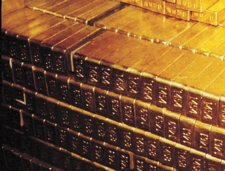 But is the gold still there? Yes, almost certainly, though we hear occasional calls for an outside audit. A more plausible accusation is that some of it has been leased to short sellers. This is a common practice among central banks that offers distinct benefits to the government. First, it earns a bit of interest income. More important, it can covertly suppress the gold price. Rising gold prices annoy Treasury secretaries and central bankers because the rise implies falling confidence in their currency. Leased gold remains in the vault and on the balance sheet even though it (or rather a paper claim on it) has been sold to someone else. Although one can find rumors on the Internet, there is no way, short of a thorough audit, to know the extent of gold leasing by the U.S. government, if any.
But is the gold still there? Yes, almost certainly, though we hear occasional calls for an outside audit. A more plausible accusation is that some of it has been leased to short sellers. This is a common practice among central banks that offers distinct benefits to the government. First, it earns a bit of interest income. More important, it can covertly suppress the gold price. Rising gold prices annoy Treasury secretaries and central bankers because the rise implies falling confidence in their currency. Leased gold remains in the vault and on the balance sheet even though it (or rather a paper claim on it) has been sold to someone else. Although one can find rumors on the Internet, there is no way, short of a thorough audit, to know the extent of gold leasing by the U.S. government, if any.
With the global economic downturn continuing and the prospect of currency wars looming, scattered voices are again suggesting a role for gold in our money. One of those voices belongs to Robert Zoellick, president of the World Bank. Could gold stage a comeback in some form?
Written by Warren C. Gibson for the Foundation for Economic Education ~ February 24, 2011

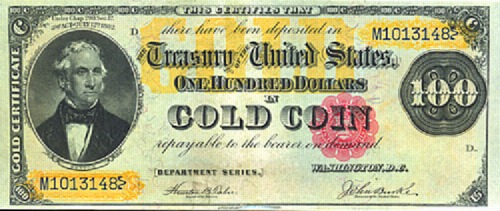 FAIR USE NOTICE:
FAIR USE NOTICE:






